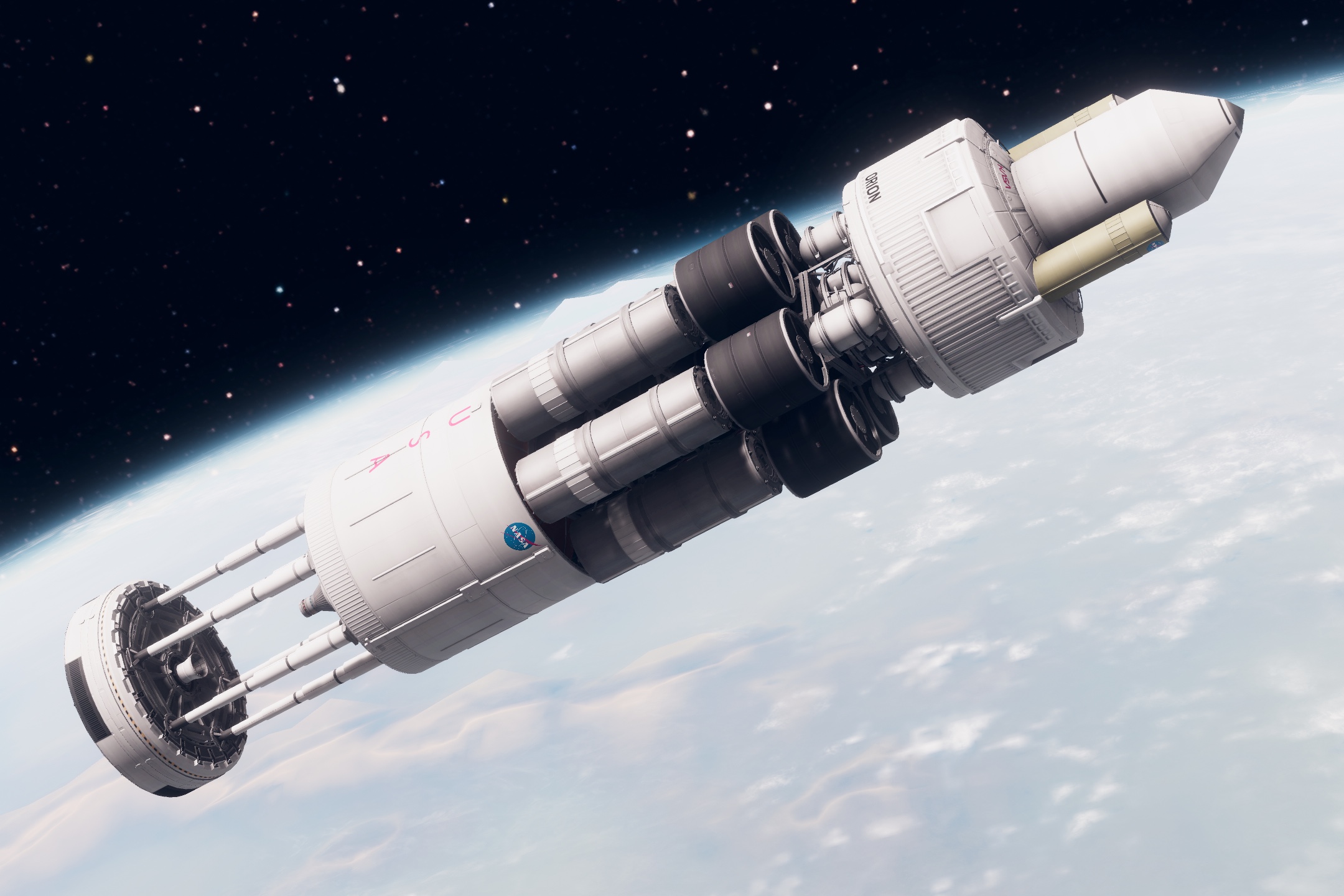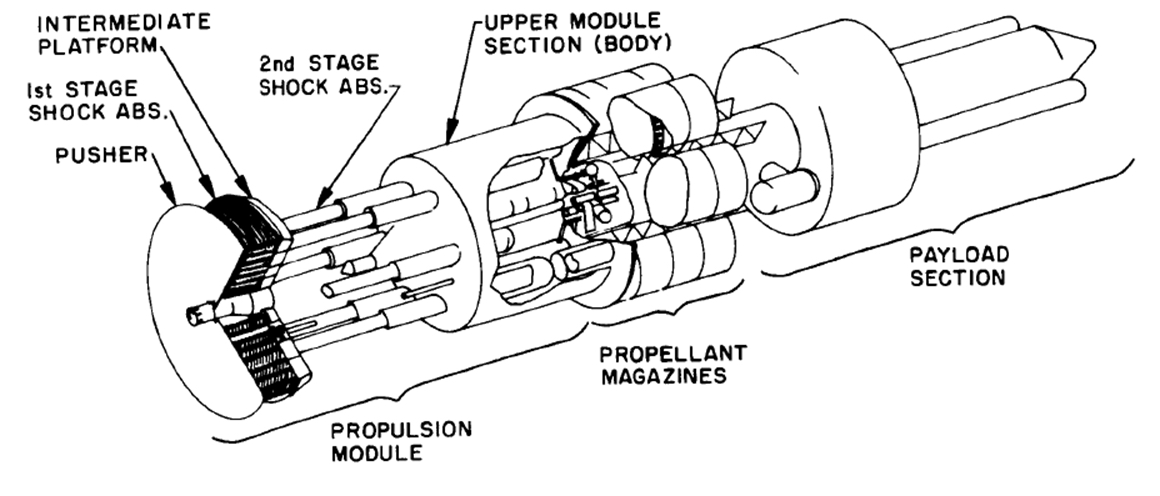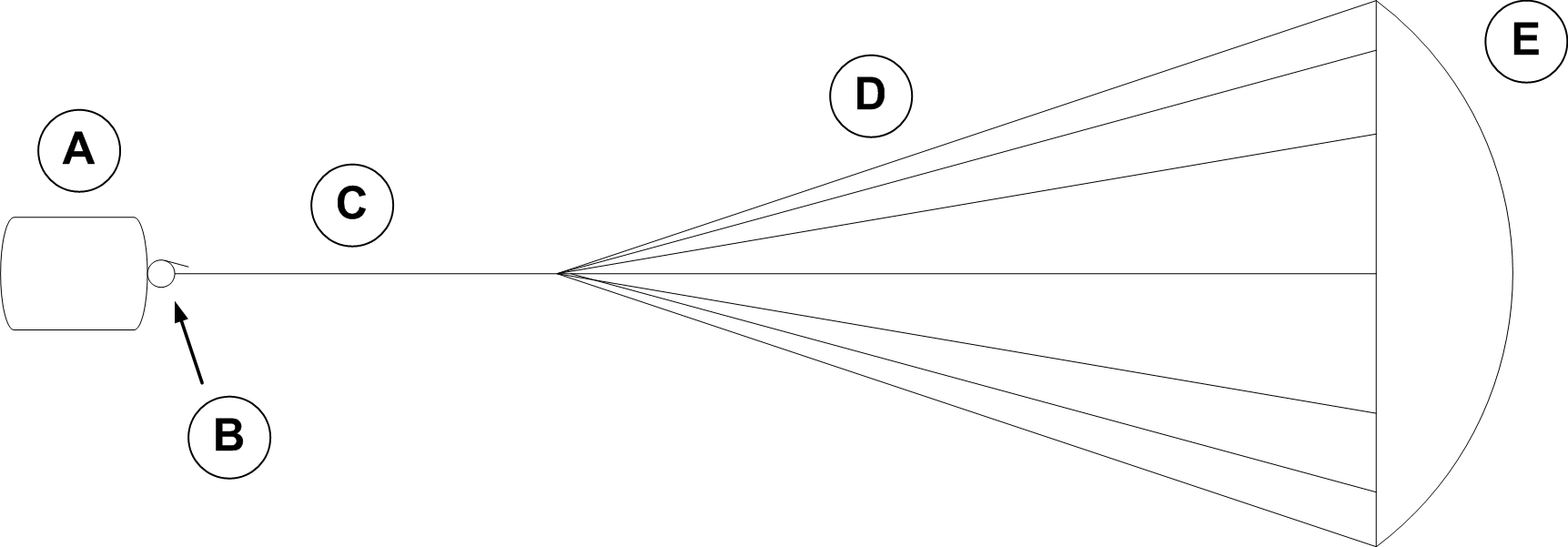Surfing to the Stars on a Nuclear Blast Wave

Interstellar Spacecraft #2: Could the destructive power of our nuclear weapons arsenal be repurposed to transport humankind to the stars?
Mark Baumann
March 30, 2022
Nuclear weapon stockpiles, by their very existence, portend a possible early demise for humankind. But, could those nuclear weapons be repurposed to guarantee the future rather than the demise of humankind by enabling us to expand our civilization beyond Earth?
This is the second article in a four-part series on interstellar spacecraft. In this four-part series, I am reviewing interstellar spacecraft concepts that could make the trip to our nearest neighboring star, Proxima Centauri. Proxima Centauri also happens to be the nearest place to look for life outside our solar system since it harbors a planet in its habitable zone.
The end goal of this series is to find an interstellar spacecraft design that can make the journey to Proxima Centauri in less than a typical human lifetime.
In the previous article I looked at chemical rockets and nuclear fusion-powered spacecraft. Chemical rockets, which have the benefit of using existing technology, cannot get us to Proxima Centauri in less than 1400 years even in the idealized optimal case. The best fusion-powered design, Icarus Firefly, could get us there in about 100 years (still longer than a typical human lifespan) but does so using technology that doesn’t yet exist.
In this article I will describe two designs for spacecraft that use another type of propulsion that is in principle available to us today: nuclear pulse propulsion.
Project Orion
Project Orion was the first and to date most thoroughly researched project to use the concept of nuclear pulse propulsion.
In nuclear pulse propulsion, the spacecraft ejects a nuclear bomb out the back. The bomb then explodes and propels the spaceship forward. The spacecraft would be protected by a massive metal “pusher plate”, and the extremely high-temperature plasma emitted by the nuclear explosion would push against the plate like a fiery wind pushing against a thick metal sail. The spacecraft would therefore “surf on waves of plasma” [1]as worded by George Dyson in the 2002 BBC documentary film To Mars by A-Bomb using a gigantic metal plate as a surfboard.
The top secret U.S. project, called Project Orion, employed the famous physicist Freeman Dyson to perform the calculations for the interstellar ship concept. Although some specific details remain secret even today, a general overview of Dyson’s calculations were published by Dyson in a 1968 paper titled Interstellar Transport [2]Dyson, Freeman, “Interstellar Transport”, Physics Today, October 1968, pp 41-45 [pdf] .
In his paper, Dyson admits that he doesn’t know the blast velocity of a nuclear explosion, nor could he tell us if he did know, and so he uses some educated guesses (i.e., order-of-magnitude estimates) to predict a range for the velocities of plasma released by a nuclear weapon explosion.
Interestingly, he mentions that such velocities are similar to the velocity of the expanding shell of debris produced by a supernova explosion, an equality that he states “may not be entirely coincidental”. Therefore the mission concept is analogous to surfing on a supernova blast wave.
He treats his estimated explosion velocities as effective exhaust velocities and applies a rocket equation-like approach (see my first article for a discussion of the rocket equation) to calculate a range of maximum velocities that the spacecraft could achieve. Those maximum velocities range from about 0.3% to about 3.3% the speed of light.
Hemispherical Design
Dyson came up with two designs. In one design, the spaceship’s pusher plate is hemispherical. A bomb detonates at the hemisphere’s center and the hemisphere, being half a sphere, absorbs half of the bomb’s blast. For this design it works out that the spaceship needs to be gigantic, with a diameter of 20 km and a hemispherical pusher plate made from 5 million tons of copper. He chose copper because it has a high heat capacity, implying it can absorb a lot of energy without melting. In addition to not melting, the accelerations felt by the spacecraft would be small enough that the copper shield could remain structurally intact.

Hemispherical spacecraft design, from “Interstellar Travel” by Freeman Dyson
Such a spacecraft would require about 30 million nuclear bombs to achieve mission velocity, giving it a fully loaded weight of 40 million tons.
The maximum achievable velocity of such a design is about 0.33% of the speed of light. At that speed, it would take about 1300 years[3]Proxima Centauri is 4.25 light years away. At 0.33% the speed of light, the journey would take 4.25/0.0033 = 1288 years. to reach Proxima Centauri.
Ablation Design
In a second, more aggressive design, Dyson proposes making the pusher plate smaller and moving it closer to the nuclear blast. In this case the pusher plate, rather than remaining fully intact, is partially vaporized by each nuclear blast. The momentum transfer from the explosion to the pusher plate can be much larger this way, but this introduces a new engineering challenge: how to absorb that much shock without damaging the spacecraft or its occupants?

Project Orion ablation design: The pusher plate is made smaller and shock absorbers are added (image credit: NASA[4]wikimedia:ProjectOrionConfiguration.png)

In the ablation design, the shock absorbers are a significant fraction of the overall spacecraft (image from 2000 paper[5]Schmidt, George R., Bonometti, J. A., Morton, P. J. “Nuclear Pulse Propulsion: Orion and Beyond”, NASA Technical Report, 2000 by NASA Marshall Space Flight Center)
To this end, Dyson goes through an argument that estimates that shock absorbers, in any scenario, can’t absorb more than 30 m/s of velocity transfer and still maintain a maximum acceleration of 1 g. A core tenet of his argument is that the bigger the shock absorber the more it can absorb, but we probably should limit the shock absorber size to be at most the same size as the object (e.g., car, spaceship, etc) that it’s protecting. A shock absorber that dwarfs the vehicle that it’s protecting has obvious drawbacks in the efficiency of such a mode of transportation.
His estimated upper limit of 30 m/s, which is about 110 kph or 70 mph, has interesting implications for automobile safety. It implies that no matter how good our designs get for seat belts, air bags, and crumple zones, the fastest that a car can be going when it hits an immovable wall and still leave the passenger unharmed is about 110 kph or 70 mph. We’re nowhere near that now; a 2011 literature review [6]Rosén, E. Stigson, H. & Sander, U., “Literature review of pedestrian fatality risk as a function of car impact speed.” Accident Analysis and Prevention, 2011 vol 43 no 1 of fatality rates in car crashes found that the fatality rate for a crash at 110 kph is about 90%. We obviously have room for improvement, but it’s interesting to note that there is an upper limit to how well we can protect our fragile human bodies from extreme accelerations (or extreme decelerations, in the case of a car crash).
Assuming optimal design (a big assumption) of the shock absorbers then gives a maximum velocity transfer of 30 m/s per explosion. With such a big momentum boost from each explosion, this spacecraft can do more with fewer bombs. Even reducing the number of warheads by a factor of 100 from the hemispherical design (down to a “mere” 300,000 bombs), the top speed of this design is about 3.3% the speed of light.
The explosions would be spaced about 3 seconds apart to accelerate the spacecraft at a steady acceleration of 1 g for 10 days to get it up to speed. So after 10 days of nuclear explosions occurring once every 3 seconds, the spacecraft would reach its cruising speed of 3.3% the speed of light.
At 3.3% the speed of light, the time to reach Proxima Centauri is about 130 years[7]Proxima Centauri is 4.25 light years away. At 3.3% the speed of light, the journey would take 4.25/0.033 = 128.8 years..
Even Orion’s ablation design could not reach Proxima Centauri in less than a human lifespan. And keep in mind that this is a theoretical upper limit based on the assumption of optimal shock absorbers. This upper limit is imposed by the fragility of human beings, which means it’s applicable not just to Project Orion, but also to any spacecraft that proposes using nuclear pulse propulsion.
Project Orion has captured the imagination of many. Some industrious fans have created mods for the space flight simulation game Kerbal Space Program, such as this one, which allow you to construct and fly an Orion spacecraft within the game (this is how the main image at the top of this article was rendered). Some artists, such as Rhys Taylor, have devoted significant talent and effort to depict the Orion spacecraft in 3D rendered art and videos, including this animation of Project Orion in flight. The “Orion Drive” even has an entry on tvtropes.com.
Project Medusa
As an interesting alternative to being pushed along by bombs exploding behind you, consider this scenario: the bombs are exploded in front of you, the blast pushes against a parachute, and the parachute in turn pulls you along. This is the concept behind Project Medusa, first proposed in 1993 by Johndale Solem[8]Solem, J. C. “Medusa: Nuclear explosive propulsion for interplanetary travel”. Journal of the British Interplanetary Society vol 46 no 1: pp 21–26..
The overall design of Medusa is similar to Orion in that the spacecraft is surfing on the nuclear explosions, in this case using a parachute like a wind sail instead of a pusher plate like a surfboard.

Project Medusa concept
(A) space capsule, (B) winch mechanism, (C) main tether, (D) riser tethers, (E) parachute
(image credit: George William Herbert[9]wikimedia:MedusaNuclearPropulsionConceptDrawing.png)

Project Medusa concept in operation (image credit: George William Herbert[10]wikimedia:MedusaNuclearPropulsionOperatingSequenceDrawing.png)
The tether is attached via a winch (B in the drawing above), like a fishing reel. When the bomb explodes (panel 2 in the diagram at right) and pushes the parachute ahead, the tether is “reeled out” some to lessen the acceleration felt by the spacecraft (panel 3). After the acceleration phase, the tether is reeled back in (panel 4) to reset the spacecraft to its initial arrangement so that the next bomb can be launched and detonated (back to panel 1).
In this way, the Medusa spacecraft extends and contracts like an inchworm as it propels its way through space at ever-increasing speeds.
Since the tether is being reeled out, not all of the nuclear explosion’s energy is being captured (indeed, this is by design since transferring 100% of the energy to the space capsule would entail zero shock absorption).
Another clever use of the tether-and-winch design is to harness some of that lost energy by attaching an alternator to the winch. When an alternator (like the one found in your car) is spun by an external agent, it produces electric current. Therefore, as the winch and attached alternator spin while the tether is being reeled out, some of the lost mechanical energy is harnessed by converting it to electrical energy. That electrical energy in turn can be used to help power systems onboard the spacecraft.
Check out this slick 3D rendered animation (created by Nick Stevens) of the Medusa spacecraft in operation, inchworm’ing its way through the cosmos:
One difference between the design I’ve described above and the one depicted in the animation is the location where the tether is reeled out; in the animation, the tether is reeled out at the middle rigging ring, whereas in the diagrams above the tether is reeled out at the space capsule. Either option works to absorb shock as well as to generate electricity (in the case of the middle rigging ring, the generated electricity can just be transferred to the spacecraft via an electrical conduit from the ring to the capsule).
Pros and Cons
Icarus Firefly, as discussed in the previous article, could get us to Proxima Centauri in about a century, but it relies on technology that we do not yet have (nuclear fusion). Nuclear pulse propulsion, on the other hand, is available to us today since we already have the stockpile of nuclear weapons. However, not all of the above-mentioned technology exists currently, in particular the “optimal” shock absorbers of the Orion spacecraft (if such a design exists, I haven’t yet seen it mentioned anywhere). The Medusa concept appears to have a more viable approach to shock absorption, however. Overall, Project Medusa seems feasible using existing technology.
In both Orion and Medusa, one design issue that wasn’t mentioned above is protecting the human passengers from dangerous radiation emitted by the nuclear explosions. In the Orion design the pusher plate can fill some of this role. The Medusa article [11]Solem, J. C. “Medusa: Nuclear explosive propulsion for interplanetary travel”. Journal of the British Interplanetary Society vol 46 no 1: pp 21–26. mentions that one of the best shields from the radiation is, perhaps surprisingly, the nuclear weapon payload itself. This is because nuclear weapons are made from high-density metals like lead, uranium, and plutonium which are good absorbers of high-energy radiation. In both designs you can see the magazine of nuclear weapons placed between the space capsule and the detonation location (i.e., in Orion the nuclear weapon magazine is in the back by the pusher plate while in Medusa the nuclear weapon magazine is in the front near the tether attachment point).
As mentioned above, a theoretical upper limit on the maximum speed of a nuclear pulse propelled spacecraft is 3.3% the speed of light. This limit applies to both Orion and Medusa, and sets a fastest travel time to Proxima Centauri of 130 years. This implies that either type of spacecraft would need to be a “colony ship” which can carry families aboard in order that someone is still alive when they arrive (i.e., those born en route).[12]Even when accounting for time dilation, a speed of 3.3% the speed of light will result in the colonists aging only about 1 month less than those who remain on Earth.
Such a speed limit could possibly be obviated if we remove human passengers altogether and make the spacecraft into an exploratory probe rather than a human transport. In that case, we could ease limitations on the acceleration that gets imparted by each blast, and nuclear pulse propulsion could potentially be used to send a probe to Proxima Centauri in less than 100 years.
The Biggest Obstacle
The biggest obstacle to using nuclear pulse propulsion isn’t an engineering obstacle but rather a political one. The Partial Nuclear Test Ban Treaty went into effect in 1963. It is an international agreement that nuclear weapons shall not be tested on Earth (except underground, hence the “partial” ban) or in space, and was put into place to both protect Earth’s population from dangerous environmental effects of nuclear weapons as well as to slow the proliferation of nuclear weapons.
When the treaty was passed, work on Orion stopped and the project was shelved. Nuclear pulse propulsion still has its advocates, however; such as Solem, who proposed Medusa in 1993, 30 years after the test ban was enacted. Solem claims nuclear pulse propulsion can be safely tested in space because the debris of the nuclear explosions is so finely dispersed that it would be undetectable and have a negligible environmental impact. As Solem says, “[t]here is no reason why nuclear explosive propulsion for interplanetary missions cannot be made politically acceptable, particularly if undertaken as an international mission.”[13]Solem, J. C. “Medusa: Nuclear explosive propulsion for interplanetary travel”. Journal of the British Interplanetary Society vol 46 no 1: pp 21–26.
In spite of the test ban treaty, a project like Orion or Medusa could actually help mitigate our nuclear weapon stockpiles. As Carl Sagan stated in 1980 in an episode of Cosmos [14]Cosmos Episode 8: Journeys in Space and Time, “[T]he Orion starship is the best use of nuclear weapons I can think of.”
If we can overcome the political obstacles, perhaps the means to our self-destruction could be repurposed to become the means to our self-propagation.
Next Article
Nuclear-powered spacecraft have been the topic of conversation so far. But there are more exotic alternatives, such as interstellar ramjets, antimatter-powered spacecraft, and solar sails. Are these purely the stuff of science fiction, or are they science fact? I’ll discuss these ideas in the next two articles of this series on interstellar spacecraft.
CLICK HERE to read the next article now!
Please sign up for my mailing list to be notified when new articles are published.
More Information
The 2002 BBC documentary film To Mars by A-Bomb explores the history of the Orion Project and some of the people behind it (particularly Freeman Dyson). Runtime is about an hour.
For a shorter video, this YouTube video also describes the concept and covers some of the history of Project Orion with a runtime of about 10 minutes. The video features a lot of great vintage photos and videos (including a fascinating video of a proof-of-concept Project Orion launch using a series of conventional non-nuclear explosives to propel a rocket up into the air). Note there is an error in the video about the speed of Orion: they claim 10% the speed of light in the video, whereas Dyson computed just 3.3% the speed of light in the optimal case. Therefore, the video quotes a shorter travel time to Proxima Centauri than we should expect.
Freeman Dyson’s 1968 paper Interstellar Transport [pdf]
Wikipedia entries for Project Orion and Project Medusa
Footnotes
